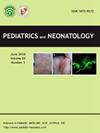Enterococcal bacteremia in children: Clinical Significance of vancomycin resistance
IF 2.3
4区 医学
Q2 PEDIATRICS
引用次数: 0
Abstract
Background
We aimed to describe the clinical and microbiological characteristics of enterococcal bacteremia, as well as the effect of Enterococcus resistance against vancomycin on clinical outcomes in Korean children.
Methods
We retrospectively reviewed the medical records of children diagnosed with enterococci isolated from blood cultures at Pusan National University Children's Hospital between December 2009 and November 2021.
Results
In total, 64 patients were enrolled in the study. The median age was 0 years (range 0–15), and 43 (67.2%) patients were male. Enterococcus faecalis (50%) was the most commonly identified bacterial strain. Significant underlying diseases were present in 60 patients (93.8%), and the source of bacteremia was identified in 36 patients (56.3%). Among these, intravascular device was the most common identifiable source. Fifty-six (87.5%) patients had previously received broad-spectrum antibiotics and 54 (84.4%) patients were nosocomial in origin. Twenty-nine (45.3%) strains were resistant to ampicillin, and 16 (25%) strains were resistant to vancomycin. All patients with vancomycin-resistant enterococci (VRE) had underlying disease (P = 0.199), and focus of bacteremia was significantly more frequent in VRE patients (P = 0.014). Of all the patients, after appropriate antibiotic treatment, five (7.8%) patients had recurrent enterococcal bacteremia, and seven (10.9%) patients were diagnosed with bacteremia, defined as other pathogens from blood culture. The 30-day mortality rate was 7.8%.
Conclusion
Enterococcal bacteremia in children is usually nosocomial and occurs in children with serious underlying diseases. Because the number of enrolled patients and mortality were small in our study, it is difficult to identify whether the factor that determines prognosis in patients with enterococcal bacteremia is VRE or an underlying disease. Further studies with a large number of patients in a specific group are needed.
儿童肠球菌菌血症:万古霉素耐药性的临床意义
本文章由计算机程序翻译,如有差异,请以英文原文为准。
求助全文
约1分钟内获得全文
求助全文
来源期刊

Pediatrics and Neonatology
PEDIATRICS-
CiteScore
3.10
自引率
0.00%
发文量
170
审稿时长
48 days
期刊介绍:
Pediatrics and Neonatology is the official peer-reviewed publication of the Taiwan Pediatric Association and The Society of Neonatology ROC, and is indexed in EMBASE and SCOPUS. Articles on clinical and laboratory research in pediatrics and related fields are eligible for consideration.
 求助内容:
求助内容: 应助结果提醒方式:
应助结果提醒方式:


